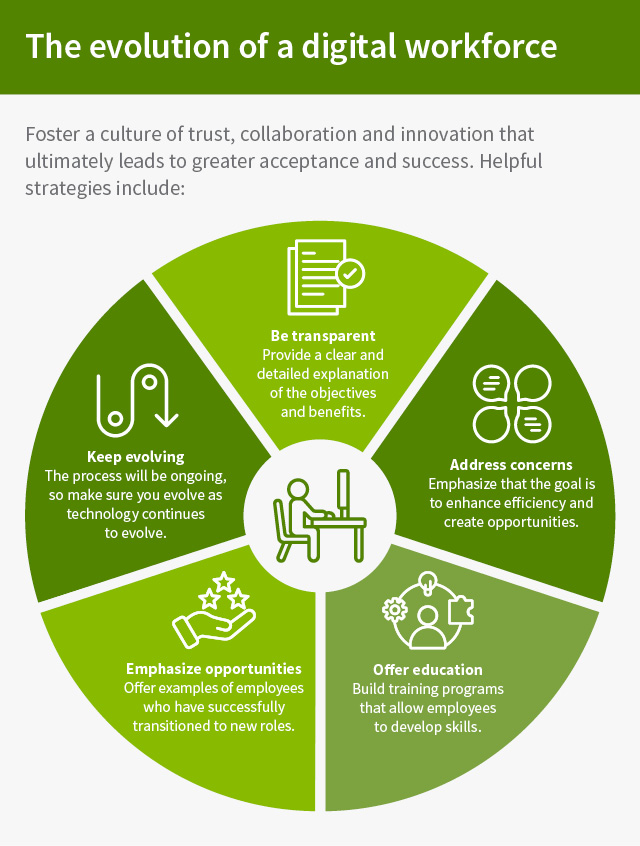Is your organization “digitally mature”? Here’s how to create a digital transformation plan that will help you compete and lead in the marketplace.
In today’s competitive business landscape, innovation is the driving force that sets companies apart and propels them toward growth and market leadership. And real innovation simply isn’t possible with a dated and outmoded technology infrastructure, which is why more organizations are having serious conversations about digital transformation.
“All successful companies innovate. It’s essential in today’s market,” says Andy Hernandez, chief digital officer of Regions Bank. “Digital transformation is a way to accelerate innovation by leveraging technology to develop new products, new services and new business models. It’s about fundamentally changing how an organization operates and delivers value to customers.”
Does so-called digital maturity lead to profits? One study of nearly 400 large companies found that digitally mature companies are 9% to 26% more profitable than their average industry competitors on several measures, including EBIT (earnings before interest and taxes) margin and net profit margin.
Digital transformation means different things to different companies, depending on their missions and needs. Ultimately, its goal is to eliminate time-consuming and cumbersome manual processes and integrate cutting-edge technologies such as cloud computing, data analytics and artificial intelligence into all aspects of your organization, says Hernandez. The potential benefits of digital transformation can touch every segment of your operation.
-
Define your needs and goals
When you are ready to rethink your digital infrastructure, begin with the right mindset. “It’s not about investing in technology for technology’s sake,” says Hernandez. “It’s about understanding your current challenges and pain points, then identifying the areas within your organization that can benefit from digital transformation.”
An important early step is conducting a technology audit, which is a comprehensive assessment of your organization’s tech infrastructure. That includes not only software, hardware, data management and networking, but cybersecurity practices and IT policies and compliance. A tech audit helps you to answer key questions, including:
- What parts of your current technology infrastructure are outdated?
- What daily procedures could be performed more efficiently?
- Where are gaps occurring in the customer experience?
Answers to these and other questions raised by your technology audit will serve as a guide as you take the next key step, which is defining your goals and objectives. “What do you want to achieve?” asks Hernandez. “Greater operational efficiency? Increased revenue? Enhanced customer satisfaction? All the above?”
Identifying your specific needs and establishing clearly defined goals can help you make sense of the many tech solutions available on the market and invest only in those that solve problems and provide real value.

-
Who’s in charge?
If your company has a chief information officer (CIO) or chief technology officer (CTO), obviously they will serve as point person on introducing new digital processes. In the absence of a CIO or CTO, oversight of a digital transformation initiative may be led by someone in senior leadership who has a comprehensive view of the organization’s strategic goals and can ensure that all proposed changes align with the company’s overall business objectives.
As an alternative, some firms appoint a cross-functional team consisting of leaders from different departments, says Hernandez. “Members of a cross-functional team can collaborate to ensure that the organization’s digital transformation includes diverse perspectives and alignment of goals,” he says. A third option is to hire an external technology consultant or advisor to help you navigate a transformation journey.
-
Make it a team effort
As part of planning your organization’s digital transformation efforts, it’s important to adopt a company-wide strategy with input and buy-in from all corners. “A company-wide strategy ensures that all departments and stakeholders are aligned toward common goals and objectives for a digital transformation,” says Hernandez. Promoting synergy not only helps to prevent “siloed” initiatives, ensuring different departments implement tech solutions that work together seamlessly, but is critical for several other reasons.
Importantly, says Hernandez, developing and adopting a company-wide strategy is essential for effective risk management. Integrating digital technology can expose a company to data security threats, which have plagued many industries. “A comprehensive strategy allows for proactive identification of risks and mitigating them, which reduces the likelihood of negative impacts on the organization,” says Hernandez, noting that today’s customers demand to know that their data is safe. “Whatever industry you’re in, you must have security at the forefront of your digital transformation.”
It’s also crucial to include your employees in your planning and to expect resistance to the changes you envision. Some associates may express fear that automation will lead to job displacement, while others will push back against the innovations you want to implement simply because they challenge the status quo—“the way we have always done things.”
“Dealing with employees who resist change or express concerns about job security requires a very thoughtful and proactive approach,” says Hernandez, noting it’s essential to involve them in the planning and decision making. “Solicit your employees’ input and ideas to ensure their concerns are heard and addressed.”
Be sure to establish key performance indicators at the outset and stay focused on them. “With any digital transformation, it’s critical to drive a culture of accountability, which includes measuring success,” says Hernandez. “It’s important to look back and ask, ‘Did we achieve our goal?’”
Start today
- Read more: Digital transformation and cybersecurity: Safeguarding your organization.
- Learn more: about digital transformation and remote workers.
- Take action: Listen to our podcast about how to keep up with digital acceleration.











